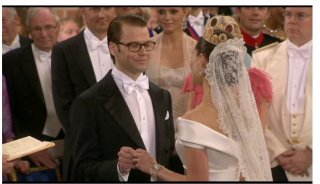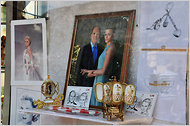The Quiet Royal Wedding
Vincent Damourette/European Pressphoto Agency
THE COUPLE Charlene Wittstock and Prince Albert II of Monaco at a charity fashion show last month.
By ELAINE SCIOLINO
Published: June 22, 201
PARIS
Enlarge This Image
Pascal Le Segretain/Getty Images
KEEPSAKES Memorabilia for the July 2 royal wedding is prominent in stores.
Enlarge This Image
Touchline/Getty Images
Charlene Wittstock competing in the South African national championships in 2004.
FOR four years, Charlene Wittstock lived mostly in the shadows, waiting for Prince Albert II of Monaco to propose.
With no job, no college degree and no knowledge of French, she was installed by him in a small apartment in the center of the tiny Mediterranean principality, far away from home in South Africa. With no official status, she appeared at the side of the prince when summoned, to smile a lot but to say little.
She endured the nastiness of the locals, who gossiped about Prince Albert’s love affairs and predicted that he would never marry her. She stayed silent as stories were embellished about his siring of two children, one with an airline hostess from Togo, the other with an American tourist from California. She bided her time by swimming, gardening, lunching, playing golf and reading in a cafe.
But Ms. Wittstock, a South African national swimming champion who competed in the 2000 Summer Olympics, applied to her love life the same determination, perseverance and stamina that had inspired her backstroke.
“There was meanness, there were jealousies,” said Stéphane Bern, a celebrity French journalist who has known her for four years. “There was the indecision of the prince. Her every move was watched and judged. But she is very strong, very natural and very direct. And it worked.”
The payoff comes July 2 with this summer’s “other” royal wedding. This time, Ms. Wittstock will be the princess stepping down the aisle (in a dress designed by Giorgio Armani). Though the event won’t come close to inspiring the global fascination of William and Kate’s nuptials almost two months ago (or even that of Albert’s own parents, Prince Ranier III and the American movie star Grace Kelly, in 1956), the
three-day celebration will nonetheless be quite a party. The event will include an open-air Mass on the Place du Palais; oceans of Perrier-Jouët Champagne; a multicourse dinner by the three-star French chef Alain Ducasse; a concert by the Eagles; a sound-and-light show and fireworks. When it is over, Ms. Wittstock, the daughter of a salesman father and a swim coach mother, will become Her Serene Highness, Princess Charlene of Monaco.
There are familiar elements of Ms. Wittstock’s experience in the story not only of Kate Middleton (pretty and patient commoner who endured snippy tabloid gossip and in the end got her prince), but also in the sadder tale of another princess: Like Diana Spencer three decades ago, she is a much younger bride of a prince with other love interests, who has been painstakingly choreographed by a palace apparatus intent on managing her image. A new episode of the soap opera will begin after the wedding. Will her royal marriage end up being a happy union based on mutual love and respect, as Kate’s seems to be so far, or a melancholy charade like Diana’s?
As with many princesses, Ms. Wittstock’s main responsibility from the outset will be to produce an heir. Although she is only 33, Prince Albert is 53, and his subjects do not want him to die before a successor is old enough to reign. (Because Prince Albert’s two children were born out of wedlock, they are barred by the Constitution from acceding to the throne.)
Ms. Wittstock has been reluctant to talk about the baby issue. Asked during an interview by the veteran French television journalist Patrick Poivre d’Arvor whether she wanted to have children who will one day succeed Prince Albert, she broke with protocol and said to the prince, “Hey, won’t he just give us a break!”
The savvy prince smoothed things over, saying, “We have the intention to start a family.”
Asked in the same interview whether she was afraid of protocol and the relentless glare of the press, she choked. “No, I am not nervous, or ... I’m quite excited actually, so ...” she said. She then turned to Prince Albert, asking, “What do you want me to say?”
“No, it’s fine!” he assured her.
Stumbles not withstanding, ever since their engagement last year, Ms. Wittstock has been preparing feverishly for her new role, with intensive lessons in French and palace protocol. Tutored, watched and corrected by an unforgiving palace guard, she has said little during her public appearances. She has granted few interviews. In at least some cases, journalists have been required to submit both written questions in advance and then the text of the interview before publication. The palace declined a request to interview her for this article.
“I thought she was one of the most anxious people I have ever met,” said Jenny Crwys-Williams, who interviewed Ms. Wittstock for South Africa’s popular Talk Radio 702 in February. “She was absolutely terrified of saying the wrong thing and falling foul of the terrible women in the palace.
“There was a fascinating moment when I asked her to tell me about an amazing blue room in the palace, and she said, ‘I don’t know if I can talk about it.’ I wanted to put my arms around her and tell her it would be all right.”
Ms. Wittstock has been both praised and vilified for appearing to imitate the style of Albert’s mother, who died in a car crash in 1982. Ms. Wittstock sometimes wears the same blond chignon, muted colors, and elegant, tailored dresses as did Princess Grace.
Before-and-after style photos of Ms. Wittstock have appeared on the Internet, with speculation about whether she has changed her teeth, breasts, eyes and nose. A recent post, under “new lips Charlene,” shows her on the cover of the German tabloid magazine Bunte with what appears to be a fuller upper lip than is evident in previous photos.
No strangers to tabloid snipes, Prince Albert’s sisters, Princesses Caroline and Stéphanie, have taken Ms. Wittstock under their wings. In an interview with Paris Match, Princess Stéphanie described Ms. Wittstock as “strong” but “very sensitive.” She added, “I try to reassure her. To help her.”
In a moment of candor in an interview with Tatler magazine last year, Ms. Wittstock acknowledged the difficulty of living in a fishbowl like Monaco, which is about half the size of Central Park. “The people I mixed with in Monaco didn’t relate to my South African mentality or humor,” she said. “Of course, I’ve been subject to jealousy, but that comes with the territory. Although I have met some wonderful people since I’ve been living in Monaco, I regard them all as acquaintances. I only have two people I consider friends here.”
In private, she is said to be blunt and direct. “She speaks very frankly to people,” Mr. Bern said. “She tells Albert, ‘I want this, I don’t want that.’ ”
Even after four years living in the principality, she seems uncomfortable speaking French, a shortcoming that has limited her social circle. (Prince Albert, who spent time with his mother’s family in the United States while growing up and studied at Amherst College, speaks flawless English.)
“Her inability to speak French is going to be a real handicap,” said Joe Little, managing editor of the London-based Majesty magazine. “Princess Maxima of the Netherlands came from the Argentine, picked up Dutch and became very popular. The former Mary Donaldson, who became crown princess of Denmark, came to grips with the Danish language quickly.”
Ms. Wittstock’s effort to try a few phrases in French in the interview with Mr. Poivre d’Arvor backfired. When he asked her whether the fact that she was not a Catholic was an obstacle to marriage in the Roman Catholic principality, she replied, “Je suis Christian.”
“Chrétienne, voilà, chrétienne,” he replied, correcting her. (She has since converted to Catholicism, the official religion of Monaco.)
Ms. Wittstock first met Albert in 2000 at a swimming competition in Monaco. A sportsman who for years occupied a spot on Monaco’s Olympic bobsled team, the prince was obviously taken with her.
She has said that as princess, she will devote herself to charitable causes, perhaps involving children and sports. She also has expressed the hope that she can help modernize the 900-year-old principality. She says would like to see Monaco have a Manolo Blahnik boutique and a Starbucks, for example. “She’s a girl in a gilded cage,” Ms. Crwys-Williams said. “Albert looks at her with great affection. She’s going to look beautiful in her Armani dress. But where the real girl is? That I really don’t know.”
A version of this article appeared in print on June 23, 2011, on page E1 of the New York edition with the headline: The Quiet Royal Wedding.




 .
. .
.
 I couldn't watch Victoria's weddding live because I had to work. I'll make sure to take the day off when Albert is finally getting married!
I couldn't watch Victoria's weddding live because I had to work. I'll make sure to take the day off when Albert is finally getting married!



